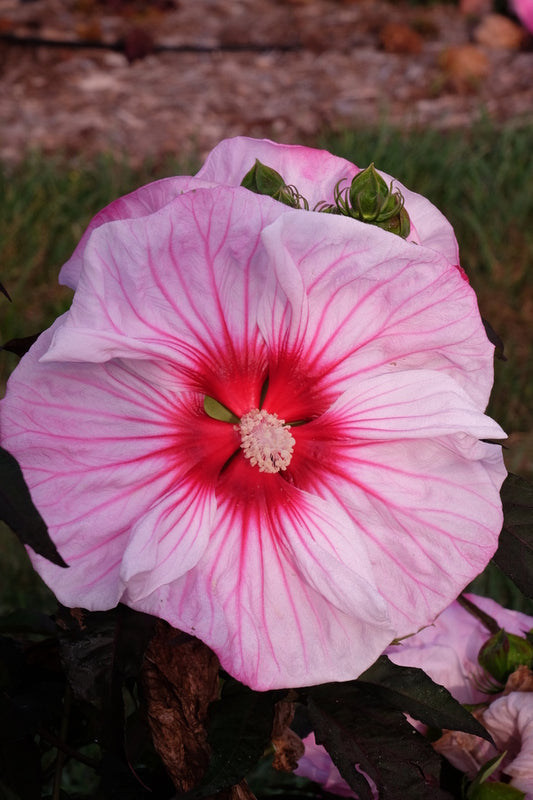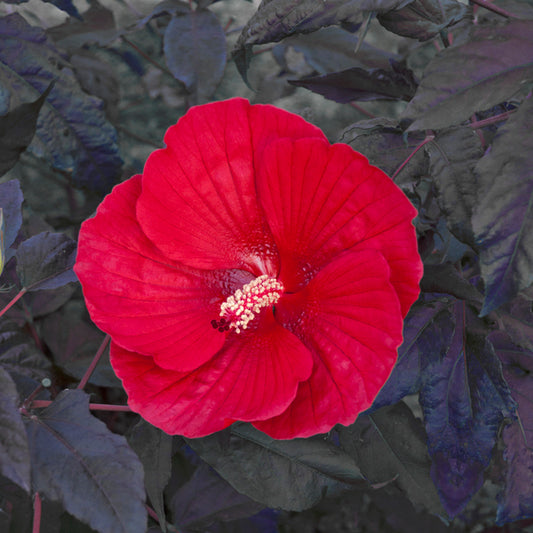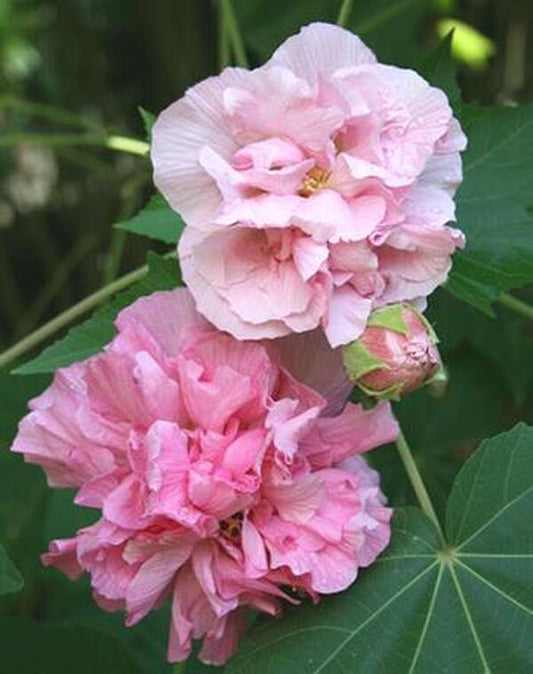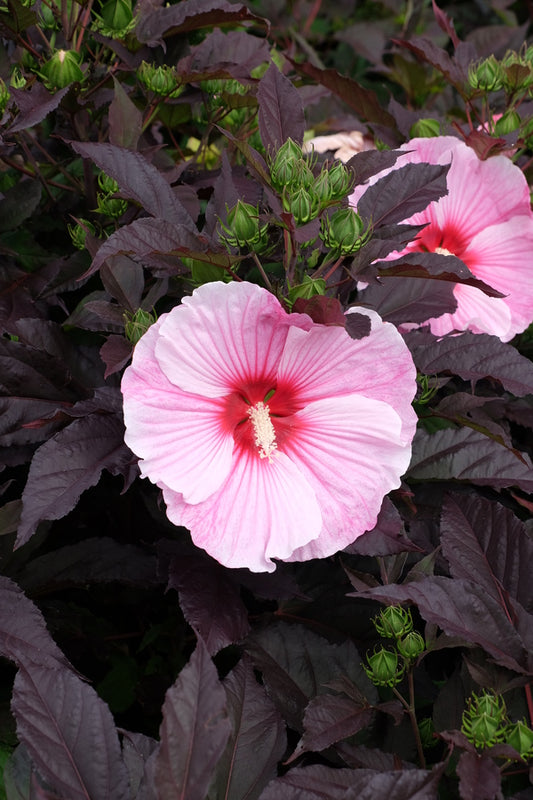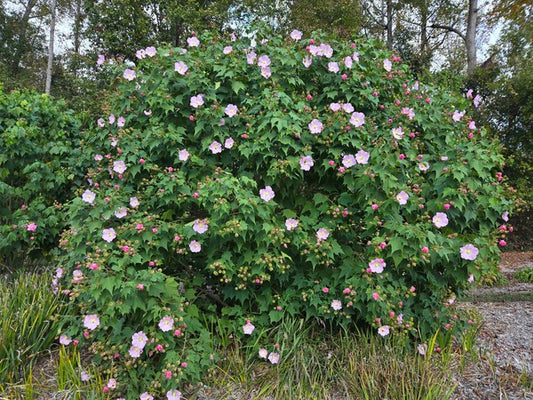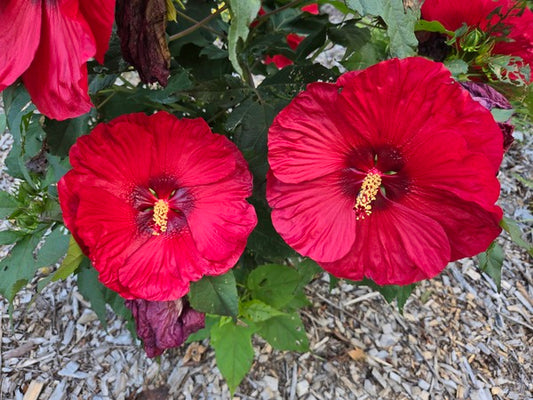Hardy hibiscus are easy-to-grow, sun-loving, native perennials with wonderful garden potential. Commonly known as the 'swamp rose mallow' or just 'rose mallow', these vigorous plants will produce flowers up to 10 inches across and offer several weeks of colorful blooms during the summer. At Plant Delights, we offer several hybrid cultivars of hibiscus that are cold-hardy as far north as Zone 4a.
-
Hibiscus 'Airbrush Effect' PP 29,295
Item #: 13757
Zones: 4a to 9b
Dormancy: Winter
Height: 48" tall
Culture: Sun to Part Sun
Origin: United States Hybrid
Pot Size: 3.5" pot (24 fl. oz/0.7 L)
Regular price $25.00Regular priceUnit price per -
Hibiscus 'Berry Awesome' PP 27,936
Item #: 11950
Zones: 4a to 9b
Dormancy: Winter
Height: 48" tall
Culture: Sun to Part Sun
Origin: United States Hybrid
Pot Size: 3.5" pot (24 fl. oz/0.7 L)
Regular price $25.00Regular priceUnit price per -
Hibiscus 'Blackberry Merlot' PP 33,498
Item #: 16521
Zones: 4a to 9b
Dormancy: Winter
Height: 54" tall
Culture: Sun to Part Sun
Origin: United States Hybrid
Pot Size: 3.5" pot (24 fl. oz/0.7 L)
Regular price $25.00Regular priceUnit price per -
Hibiscus 'Cherry Choco Latte' PP 30,738
Item #: 13758
Zones: 4a to 9b
Dormancy: Winter
Height: 48" tall
Culture: Sun to Part Sun
Origin: United States Hybrid
Pot Size: 3.5" pot (24 fl. oz/0.7 L)
Regular price $25.00Regular priceUnit price per -
Hibiscus coccineus
Item #: 1215
Zones: 6a to 9b
Dormancy: Winter
Height: 96" tall
Culture: Sun
Origin: United States
Pot Size: 3.5" pot (24 fl. oz/0.7 L)
Regular price $25.00Regular priceUnit price per -
Hibiscus 'Cookies and Cream' PP 35,736
Item #: 18260
Zones: 4a to 9b
Dormancy: Winter
Height: 36" tall
Culture: Sun to Part Sun
Origin: United States Hybrid
Pot Size: 3.5" pot (24 fl. oz/0.7 L)
Regular price $25.00Regular priceUnit price per -
Hibiscus grandiflorus
Item #: 1120
Zones: 6a to 9b
Dormancy: Winter
Height: 96" tall
Culture: Sun
Origin: United States
Pot Size: 3.5" pot (24 fl. oz/0.7 L)
Regular price $25.00Regular priceUnit price per -
Hibiscus 'Holy Grail' PP 31,478
Item #: 13759
Zones: 4a to 9b
Dormancy: Winter
Height: 54" tall
Culture: Sun to Part Sun
Origin: United States Hybrid
Pot Size: 3.5" pot (24 fl. oz/0.7 L)
Regular price $25.00Regular priceUnit price per -
Hibiscus 'Midnight Marvel' PP 24,079
Item #: 1781
Zones: 5a to 8b, at least
Dormancy: Winter
Height: 60" tall
Culture: Sun to Part Sun
Origin: United States Hybrid
Pot Size: 3.5" pot (24 fl. oz/0.7 L)
Regular price $25.00Regular priceUnit price per -
Hibiscus mutabilis 'Flora Plena'
Item #: 1126
Zones: 7b to 10b
Dormancy: Winter
Height: 120" tall
Culture: Sun
Origin: China
Pot Size: 3.5" pot (24 fl. oz/0.7 L)
Regular price $38.00Regular priceUnit price per -
Hibiscus 'Perfect Storm' PP 27,880
Item #: 11951
Zones: 4a to 9b
Dormancy: Winter
Height: 36" tall
Culture: Sun to Part Sun
Origin: United States Hybrid
Pot Size: 3.5" pot (24 fl. oz/0.7 L)
Regular price $25.00Regular priceUnit price per -
Hibiscus 'Spinderella' PP 33,309
Item #: 16519
Zones: 4a to 9b
Dormancy: Winter
Height: 54" tall
Culture: Sun to Part Sun
Origin: United States Hybrid
Pot Size: 3.5" pot (24 fl. oz/0.7 L)
Regular price $25.00Regular priceUnit price per -
Hibiscus 'Starry Starry Night' PP 27,901
Item #: 11952
Zones: 4a to 9b
Dormancy: Winter
Height: 48" tall
Culture: Sun to Part Sun
Origin: United States Hybrid
Pot Size: 3.5" pot (24 fl. oz/0.7 L)
Regular price $25.00Regular priceUnit price per -
Hibiscus 'Summer Carnival' PP 31,587
Item #: 13724
Zones: 4a to 9b
Dormancy: Winter
Height: 42" tall
Culture: Sun to Part Sun
Origin: United States Hybrid
Pot Size: 3.5" pot (24 fl. oz/0.7 L)
Regular price $25.00Regular priceUnit price per -
Hibiscus 'Tioga Party'
Item #: 18096
Zones: 7b to 10b
Dormancy: Winter
Height: 144" tall
Culture: Sun
Origin: Hybrid
Pot Size: 3.5" pot (24 fl. oz/0.7 L)
Regular price $29.00Regular priceUnit price per -
Hibiscus 'Valentine's Crush' PP 35,170
Item #: 18387
Zones: 4a to 9b
Dormancy: Winter
Height: 60" tall
Culture: Sun to Part Sun
Origin: United States Hybrid
Pot Size: 3.5" pot (24 fl. oz/0.7 L)
Regular price $25.00Regular priceUnit price per
More Information About Hibiscus
Hibiscus plants flower mid-to-late summer and produce amazing blooms that attract a variety of pollinators including butterflies and hummingbirds. We have trialed many perennial hibiscus species over the years both at Plant Delights Nursery and at Juniper Level Botanic Gardens and have selected the best cultivars of hardy hibiscus plants to offer to the public.
Hibiscus (Rose Mallow) Care
Hibiscus are amazingly tolerant to the heat and humidity of the southern US provided they are watered deeply and regularly. These North American native plants love full sun and grow equally well in soggy soil, as a marginal aquatic or in typical garden conditions. If the soil is too dry, however, they can be susceptible to leaf scorch. Although some hardy hibiscus emerge from dormancy fairly late, they quickly grow to maturity.
When to Plant Hibiscus
The best time to plant hibiscus is anytime when you can keep them adequately watered. If you purchase a plant that is already in growth, be sure to plant after the danger of frost has passed.
Sun and Water Requirements
Full sun and, moist soil will give you the largest flowers and lushest foliage. Keep your hibiscus well-watered since they are not drought tolerant. If you see any wilting or leave loss, then increase your watering duration and/or schedule.
Fertilizing Hibiscus
Rose Mallows respond best to simple organic fertilizer. A fresh topping of compost once per year is sufficient for most.
Pests and Diseases
Hibiscus can be susceptible to a variety of pests including aphids, whiteflies, Japanese beetles, and spider mites if they are under stress. When plants are grown in proper conditions (moist, rich soils with a pH 5.5-6.5), sawfly larvae should be the only problematic pest. Most pests can be controlled with common organic insect controls. Fungal problems can be prevented by maintaining proper ventilation around the plant and by removing any dead or diseased leaves.
Bloom Time
Hardy hibiscus blooms typically emerge in mid to late summer and display huge, tropical-like flowers of red, pink, white, yellow, or purple. Be aware that the amount of sun and water effect the size and timing of flowers. Deadheading (removing faded flowers) while not necessary, can improve the appearance of your hibiscus.
Using Hibiscus in the Garden
Gardeners love hibiscus plants not only for the colorful flowers but also for the hardiness and vigorous growth. Few perennials give you more bang for your buck than a hibiscus. We love to use them as border plants in place of shrubs, bog plants, and even as a focal point. They are a fantastic addition to any cottage garden and do great in containers. Be sure to give them plenty of space as they can grow quite vigorously during the summer months and get as wide as 5-6 feet.
Dormancy and Winter Care
Hardy hibiscus will enter dormancy during the fall in Zones 4a to 8b. We prefer to leave the architectural stalks up over winter, both from a design perspective, but they also provide a perch for birds and a home for overwintering pollinators. The stalks can be cut down to the ground in spring before new growth emerges.
Hibiscus Companion Plants
Hardy hibiscus love water and pair well with brightly colored bog garden plants and with other water-loving rain garden plants. Here are just a few selections to get you started:
- Asclepias tuberosa
- Baptisia 'Pink Truffles'
- Canna 'Flaming Kabobs'
- Colocasia esculenta 'Black Coral'
- Crinum 'Sangria'
- Geranium 'Rozanne'
- Sarracenia 'Dutch Stevens'
- Spigelia marilandica 'Little Redhead'
Hibiscus is in the mallow family which includes other popular garden plants. Check out all the mallows we offer here.
For more information on how to grow and care for hibiscus, read our Eleven Easy Tips for Growing Hardy Perennial Hibiscus and be sure to visit the JLBG blog for even more pictures and information related to the hibiscus plants for sale at Plant Delights Nursery.





